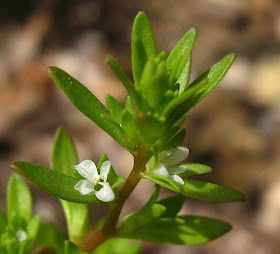New York botanists are concerned that the Nodding Trillium (Trillium cernuum) is "becoming more rare and may be in trouble." That's what I read yesterday on the New York Flora Association's blog, where botanist Steve Young asked anyone who finds this flower to contact the NYFA. So I'm sure you can guess where I headed today. That's right, out to look for those trilliums. They used to grow abundantly each spring along the Bog Meadow Trail just east of Saratoga Springs, but a few years ago their summer leaves got mowed down, and their numbers have dwindled alarmingly. I still find one or two if I search carefully. Here's a picture of one I took in mid-May last year, when I walked the trail with the man who maintains it, pointing out areas not to be mowed.

Since so many flowers are blooming early this year, I thought I might find a Nodding Trillium at least in bud. But no luck. I had just given up the search when I spied a few three-leaved shoots coming up near where I found those trilliums last year. I'm not sure, but these might be T. cernuum. I'll be watching them to see if they are.
Even if I didn't find what I sought, it sure was a beautiful day to be on the trail, so sunny and summery warm. And one of my very favorite flowers was just opening its buds: Star-flowered Solomon's Seal, its waxy white blossoms set off so beautifully against its blue-green leaves.
A Pin Cherry tree somehow got bent down low to the ground, which allowed me a close-up view of its pretty white blooms. The reddish-brown bark of its flowering twigs is diagnostic for this native cherry.
The Highbush Blueberry shrubs were heavy with bloom, the bulbous white blossoms topped with greenish pink calyx lobes that remind me of pixy caps.
All along the trail, Dwarf Raspberry bloomed, its tiny flowers almost invisible, but worth a closer look.
Maple-leaved Viburnum is lovely in every season: early summer brings clusters of tiny white flowers tinted pink, the autumn brings leaves of the most amazing purplish-coral color, and the blue-black berries cling to the shrub all winter. But even now it delights the eye, with tight-curled buds and glossy just-opening leaves, all arranged so symmetrically.

I know of one other place where I once found Nodding Trillium, but I haven't found it there for several years. That's the Orra Phelps Nature Preserve in Wilton. On the NYFA blog I mentioned above, there's a map that shows the distribution of T. cernuum in the past. That map shows just one dot representing its presence in the Saratoga area, and Steve Young told me that that dot represents the report that Orra herself provided in 1926. What a shame it would be to lose this beautiful trillium from our area. So keep your eyes peeled for it, and if you do find it, please contact Steve Young at young@nynhp.org.


























































